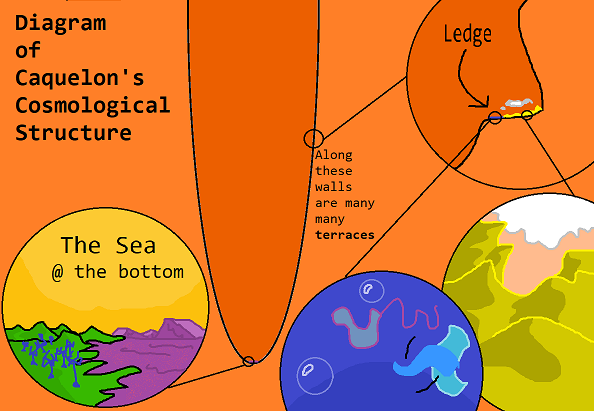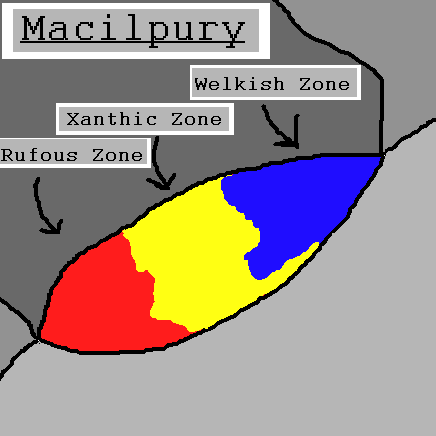Cosmology
In this world there’s no sun or stars. No night or day. No planets or atoms.

It’s just an infinite three-dimensional concave parabola with a sea of goop in the bottom that’s big enough to submerge several gas giants. The walls of the parabola go up and up and up forever with no end in sight.
Cut in the sides of the parabola are terraces or ledges that’re mostly shaped like lenses or crescents. The closer you are to the sea the bigger the terraces are. By laymen, these terms are often used interchangeably but for the purposes of this lecture the smaller ones are called ledges while the bigger ones are called terraces. They’re habitable zones with the potential to develop life, making them a clear parallel to our planets.
In this universe there’s one kind of matter. It’s called hyloplasm or just hyle for short. It’s got no atoms in it. It’s infinitely divisible which means there’s no limit to how small a hyle object can be. By virtue of being apart from the parabola, each individual object has its own innate life force and with it its own unique potential to develop intelligence thanks to the principle of Hylozooism.
The physical properties of every hyle object depend on the mental forces that are currently acting on it. Conversely, each object made from hyle has its own degree of mental power. The more intelligent an object is, the more resistant it is to the influence of other minds, which means that inanimate objects tend to take on the properties of the matter which makes up its surroundings.
Which brings us to the most noticeable phenomena of this universe.
Influence Zones
Certain areas influence the properties of objects within them to be more like their surroundings. These are known as influence zones.

In these zones a rock in a beach will gradually erode into sand. The same rock placed into a lake will soften into mud, then dissolve into water. The ones that don’t undergo the same change can be said to have an equal or higher level of mental force than the zone.
The one at the top
Concentrated at the top of Caquelon, if there even is one, is a cosmic mind which ensures everything that is not part of the ledges or the sea becomes harder the higher up you go along the walls. It acts as one giant influence zone. By default, the hyle that makes up the parabola is hard but also bouncy. Like rubber it absorbs force. It can’t be damaged by blunt forces, but it also has a weak shear resistance so it can be cut with sharp implements.
The one at the bottom
At the bottom of Caquelon (which unlike the former can be said to exist) is another mind whose power exclusively extends over the sea. It’s said to be concentrated around a point at the nadir of the parabola, which can be proven to exist unlike the one at the top. The sea is perfectly round and made up of a strange oobleck, the viscosity of which is somewhere between honey and fondue. All non-sapient matter such as rocks, trees or carcasses dissolve into the sea within hours.
It is the place from which everything comes and the place to which everything goes.
Life
The mental force exerted by influence zones is passive as it is equally applied to every object within the confines of its borders. However, the mental force that living things have is active, since living organisms have a will of their own which they can use to select which object their mental force is being allocated to.
Caquelon’s ecology can be best compared to an eat ‘em up game. For those unfamiliar with the concept a modern example would be that browser game which takes its name from the jelly used in petri dishes. If you’re as old as I am you might have played it in class before.
All living things on Caquelon are formed through spontaneous generation. This happens when an inanimate object absorbs a sufficient degree of mental force from its surroundings. Once it has taken in the right amount of intelligence, it becomes capable of absorbing other beings into itself. More developed beings have the psionic ability to melt other beings with mental force.
There are no cells in Caquelon. The difference between animals and plants is that animals move and plants do not.
As there isn't any wind or water, things like fire, clouds and and lightning are considered living things because they can move and are made of matter. They participate in the ecosystem which means it's possible to be eaten by a hungry cloud.
Since there has never been any such thing as sex here (until very recently) everything reproduces by division. All organisms grow larger with every meal. When it is too heavy to move it splits into two lesser beings. When it is too small it merges with another or finds something to eat.
Additionally, every time an organism absorbs another it absorbs the mental faculties of its prey. It is also worth noting that an organism cannot absorb mental energy and physical matter at the same time, so one is expelled and another consumed. Most predators eject mental energy from devoured prey back into the ground. A few do not.
This has led to several terraces developing their own sapient races. But before we look at that let's observe the conditions which create one.

This terrace is divided into three zones, each one a different colour. These are the Rufous Zone, the Xanthic Zone, and the Welkish Zone. They are composed from hyle that is red, yellow, and blue respectively.
Because of Macilpury's small size each type of hyle is zooically active meaning they are prone to spontaneous generation.
That being said, each zone is capable of generating seven base plants and two base animals. This means there are twenty-one base plants and six base animals in total. Since there is no sexual reproduction, every animal is capable of fusing with another to form a hybrid. Of the thirty-six possible animals, thirty of them are hybrids of the six base animal species.
Rufous Zone
Hyle: Rufous Zone is solid and stable like stone. It resembles a hardpan desert, or a hamada. It's so flat you can see the end.
Wildlife: The Whirligig, a round animal shaped like a wheel, and the Treadler, which propels itself with a spring.
Xanthic Zone
Hyle: soft and made up of grains shaped like oblate spheroids. Depending on how wettightly packed the grains are it can behave like sand or clay. The terrain of this Zone is varied, with mountains and spires overlooking valleys and flats.
Wildlife: The Lurker, a long creature that burrows underground with its wedge-shaped head. It typically hides from the Prowler, an agile climbing predator.
Welkish Zone
Hyle: Fluid with a consistency much like water, but vividly blue in colour and very opaque. Its most peculiar quhality is its psychic malleability, which means that the application of sufficient mental force can change its physical properties. For example anyone who applies their attention on a piece of blue hyle can force it to crystallize like ice. In its default state it is typically known as water.
Wildlife: The Tuinfero is a swimming creature that propels itself through the water by swinging its tail side by side. It spends the entirety of its life in the Welkish Zone. In contrast the Augnil is amphibious, being a laterally oriented swimming creature that propels itself through water and across land by swinging its tail up and down.